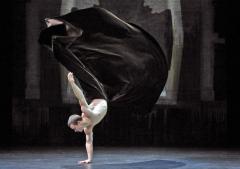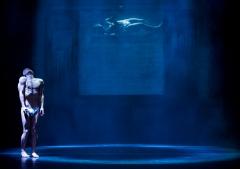
Jack Anderson
| Meryl Tankard's "The Oracle" Meryl Tankard’s “Rite”
Stravinsky’s “Rite of Spring” is a century old
this year, and with “The Oracle,” the Australian choreographer
Meryl Tankard makes her contribution to the anniversary celebrations.
The clamorous score has tempted choreographers ever since its premiere
on May 29, 1913. But until only recently, it also terrified them.
With its strange harmonies and complex rhythms, many choreographers
thought it defied staging and, possibly, the superstitious among them
took it as an inauspicious omen that Vaslav Nijinsky, its original
choreographer, went mad. “Rite” is no longer a rarity. And its anniversary year will surely prompt a host of new “Rites.” But this raises a fresh problem. Both “Rite” and the types of choreographic responses it has tended to elicit over the years may be now be so familiar that new choreographers of the work may be tempted to struggle hard for odd images just in order to make an impression. “The Oracle” fortunately avoids gimmickry; nevertheless, it may impress some viewers primarily because of its theatrical effects, which are considerable, rather than for being a sustained dramatic or thematic narrative.
When the first notes of Stravinsky’s score are heard in a recording by Kent Nagano and the London Philharmonic, White is revealed bending and stretching his long limbs across the floor. As the action progresses, he often struggles with a big piece of drab brown cloth, which he sometimes wraps around his waist, rests atop his head like a headdress, or lets dangle toward the floor like an enormous fall of hair. There are also scenes in which he is nude, moments in which he is held within a circle of light, and a sequence in which he steps forward in a path down a cloud of white dust.
Video makes it possible for him to dance duets with himself. But
the most fascinating mixed-media effects are those in which images
of White’s body are manipulated, replicated and projected on
the backdrop like shapes in a kaleidoscope. |
| museums | NYTW mail | recordings | coupons | publications | classified |



